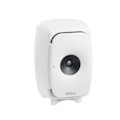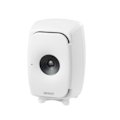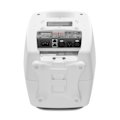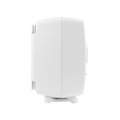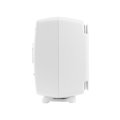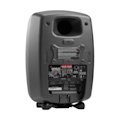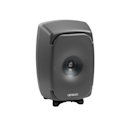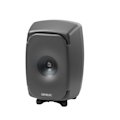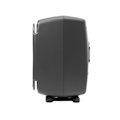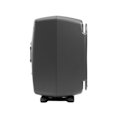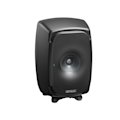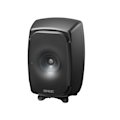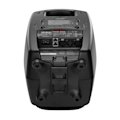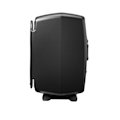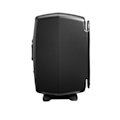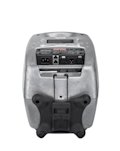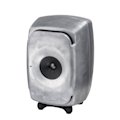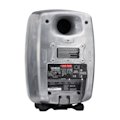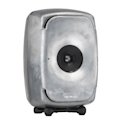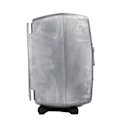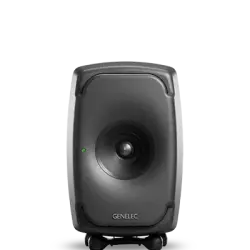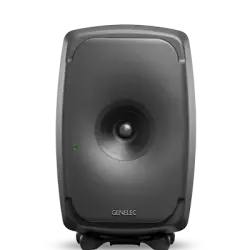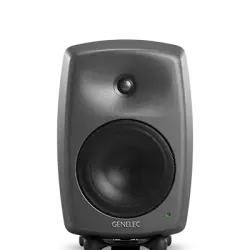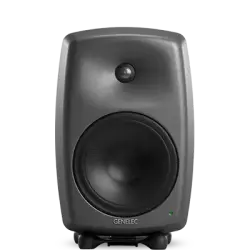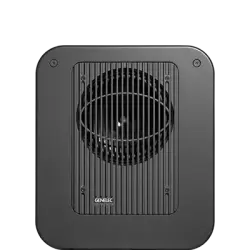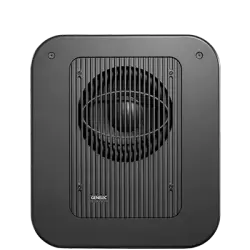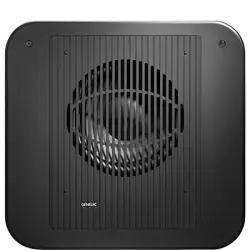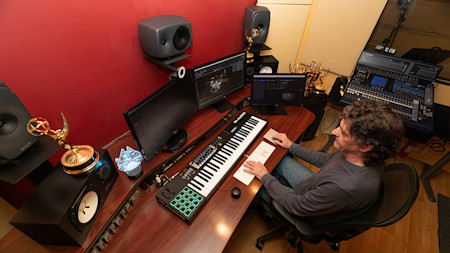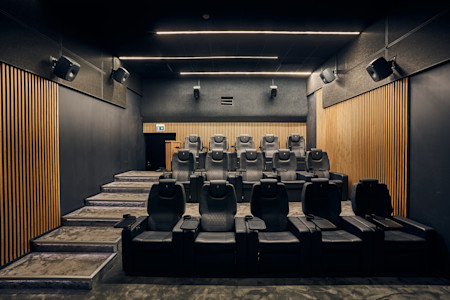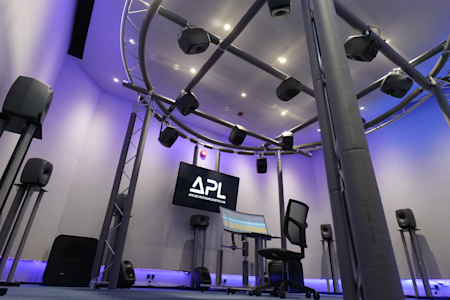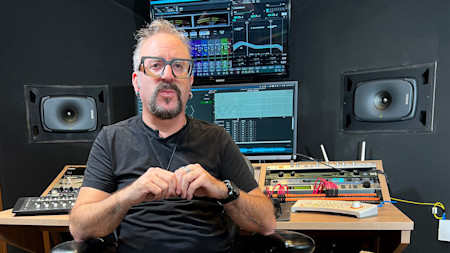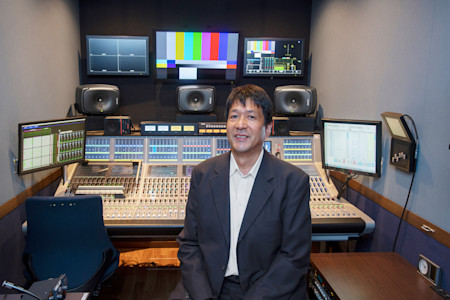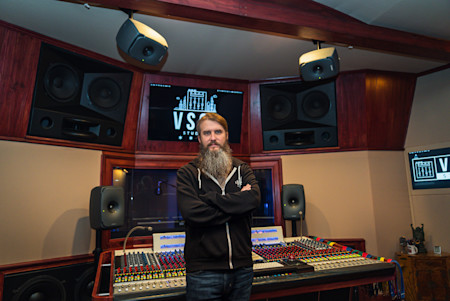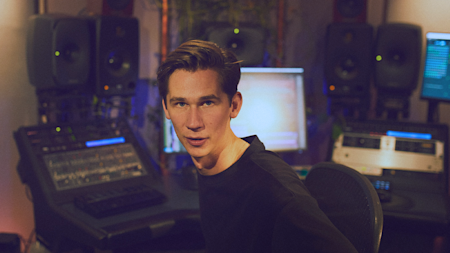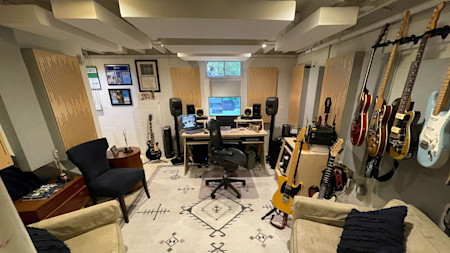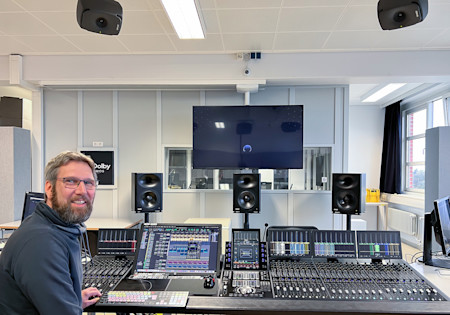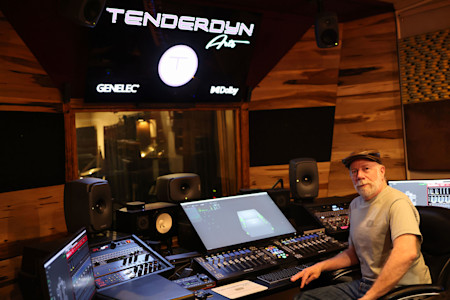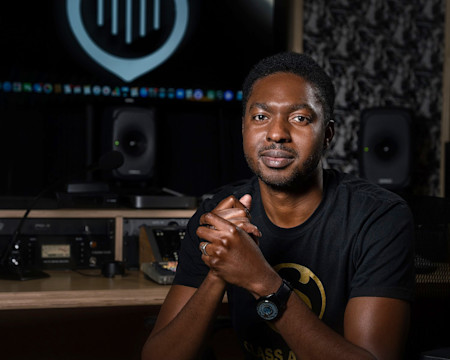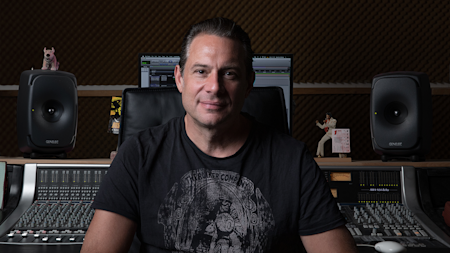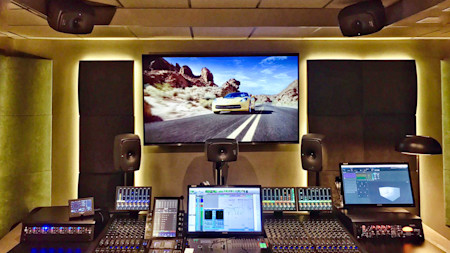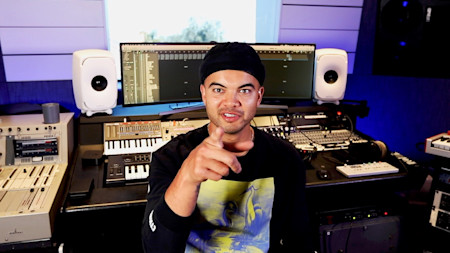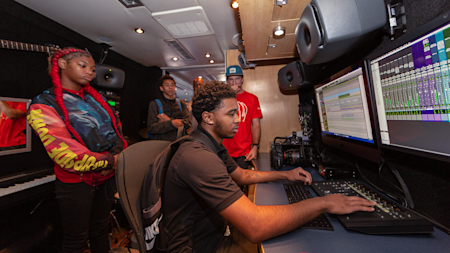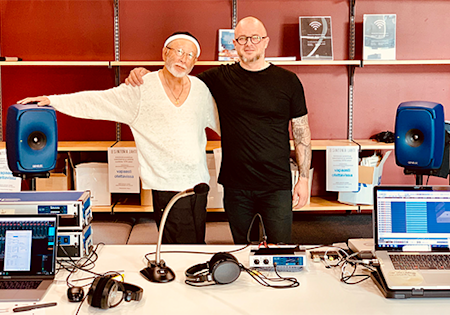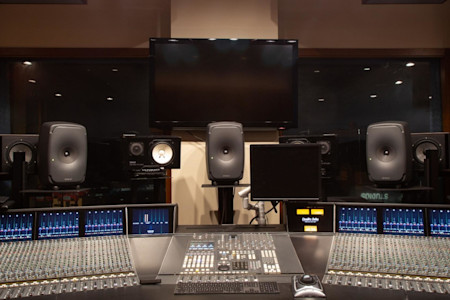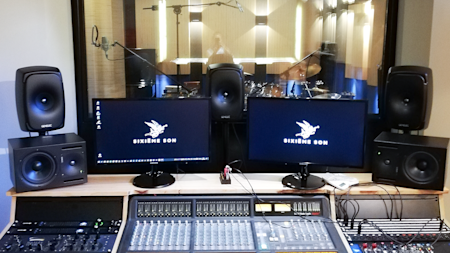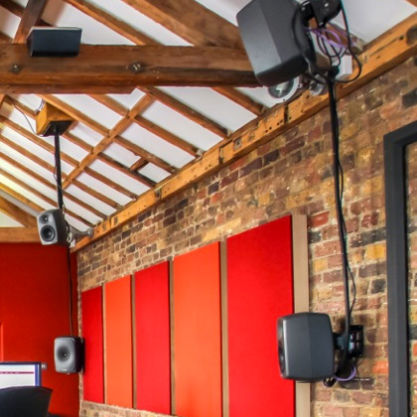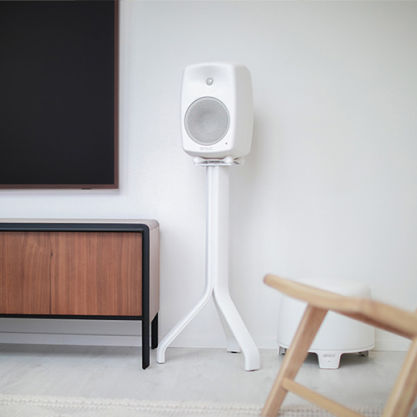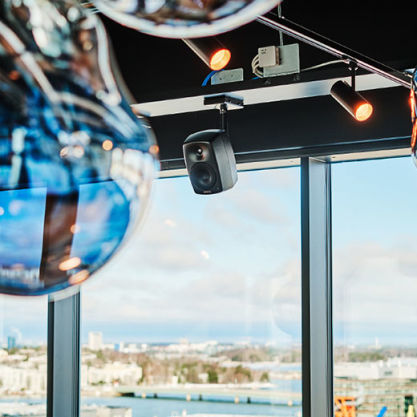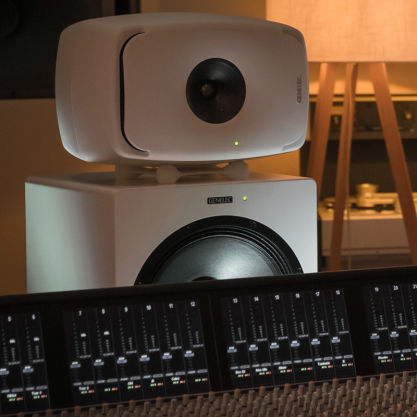Erittäin suorituskykyinen 8341 on akustisesti koaksiaalinen tarkkailukaiutin, joka toimii lähes täydellisenä pistesäteilijänä.
8341A
SAM™ Studiomonitori

Smart Active Monitor (SAM™)

Minimum Diffraction Coaxial (MDC™)

SPL
110 dB

Taajuusvaste
38 Hz - 37 kHz (-6 dB)

Mitat
H 370 x W 237 x D 243 mm, Iso-Podin kanssa™ (muunna tuumiksi)

Työskentele nopeammin ja kauemmin
Mikäli tarvitset poikkeuksellisen tarkan äänikuvan, kompaktin kotelokoon ja matalille taajuuksille ulottuvan rasittamattoman äänentoiston, The Ones –tuoteperheen aktiiviset tarkkailukaiuttimet ovat täydellinen ratkaisu. Tuotteet ovat akustisesti koaksiaalisia ja ne toimivat lähes täydellisenä pistesäteilijänä, mikä mahdollistaa erittäin lyhyen minimikuunteluetäisyyden ja laajan kuuntelualueen. Malliston kaiuttimissa lukuisat tekniset innovaatiot yhdistyvät ympäristöystävällisiin valmistusmenetelmiin ilman kompromisseja.
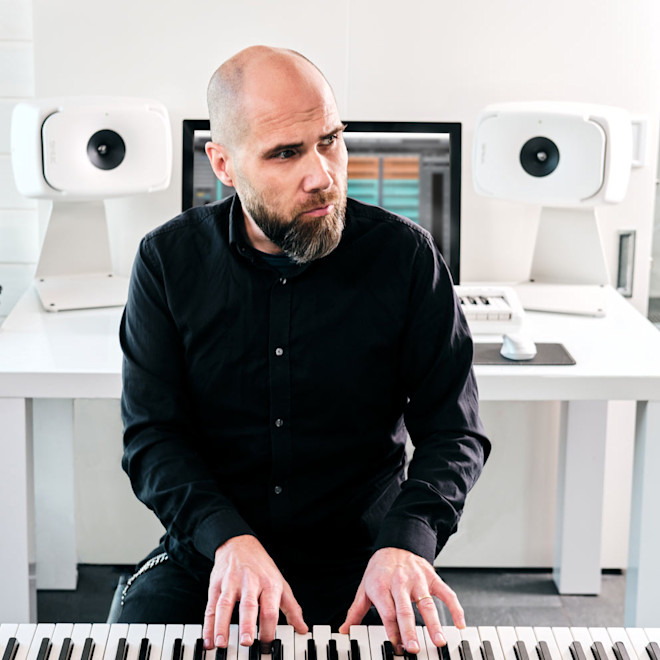
Monipuolisuutta ja suorituskykyä
8341 on oivallinen valinta erilaisiin sovelluksiin stereolähikenttäkuuntelusta aina immersiivisiin monikanavajärjestelmiin saakka. Pienestä koostaan huolimatta 8341 tarjoaa todella korkean maksimiäänenpaineen sekä erinomaisen basson ulottuvuuden. Kompakti kotelo, erittäin vakaa suuntaavuuden hallinta sekä monipuoliset kiinnitysmahdollisuudet tekevät tästä kaiuttimesta monipuolisen työkalun erilaisiin käyttöympäristöihin.
Genelec
8341A SAM™ studiomonitori valkoinen
8341A SAM™ Studiomonitori tummanharmaa
8341A SAM™ Studiomonitori musta
8341A SAM™ Studiomonitori RAW
8341A
Palkinnot

Genelec's The Ones monitors were awarded a "Producto del Año 2017" award by Hispasonic.
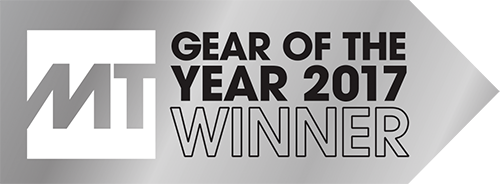
Genelec SAM™ Coaxial Studio Monitors 8331, 8341 and 8351, also known as "The Ones", were awarded with the MusicTech Gear of the Year 2017 award in "Product of the Year" -category.
Genelec's The Ones monitor series was awarded a Super AV Award 2017 in the category of Outstanding Overall Performance.

Genelec SAM™ Coaxial Studio Monitors 8331, 8341 and 8351, also known as "The Ones", were awarded with the MusicTech Gear of the Year 2017 award in "The Best Monitors" -category.
Genelec's The Ones monitors were awarded a IFTT C&C Award 2017 (International Film and Television Technology Creative & Craft Award).
Genelecs The Ones monitors were awardede a Beijing International Music & Hi-Fi Show award 2017 in the category of "Most Influential Product".
Genelec SAM™ Coaxial Studio Monitors 8331, 8341 and 8351, also known as "The Ones", were awarded a SOS Global Readers Award 2018 in "Highly Commended" -category.
Genelec 8331 and 8341 Compact Coaxial Monitors were awarded a TEC (Technical Excellence and Creativity) Award 2018 in the category of Studio Monitor Technology.
Genelec's The Ones series monitors were awarded a Resolution Award 2018 in the "Monitoring" category.
Tekniset tiedot

SPL
110 dB

Vahvistimen teho
250 W Basso (Class D) + 150 W Keskiääni (Class D) + 150 W Diskantti (Class D)

Taajuusvaste
38 Hz - 37 kHz ("-6 dB")

Taajuusvasteen tarkkuus
± 1.5 dB (45 Hz - 20 kHz)

Kaiutinelementtien mitat
2 x H 90 x W 170 mm Basso + ⌀ 90 mm Keskiääni + ⌀ 19 mm Diskantti (muunna tuumiksi)

Mitat
H 370 x W 237 x D 243 mm, Iso-Podin kanssa™ (muunna tuumiksi)

Paino
9.8 kg / 21.6 lb

Liitännät
1 x XLR Analoginen Sisääntulo
1 x XLR AES/EBU Sisääntulo
1 x XLR AES/EBU Ulostulo
2 x RJ45 Ohjaus
8341A SAM™ Studio Monitor
SAM™ Studiomonitori
Tekniset tiedot
Erittäin suorituskykyinen 8341 on akustisesti koaksiaalinen tarkkailukaiutin, joka toimii lähes täydellisenä pistesäteilijänä.

Järjestelmän tiedot
Taajuusvaste
45 Hz - 20 kHz (± 1.5 dB)
Alarajataajuus -6 dB
38 Hz
Ylärajataajuus -6 dB
37 kHz

SPL
Maksimiäänenpaine Maksimiäänenpaineen piikki, kaiutinpari mitattuna kuunteluhuoneessa musiikkimateriaalilla 1 metrin etäisyydeltä.
≥118 dB
Hetkellinen maksimiäänenpaine Lyhyen ajan maksimiäänenpaine siniaallolla puoliavaruudessa, keskiarvo 100 Hz - 3 kHz, 1 metrin etäisyydeltä.
≥110 dB
Pitkäkestoinen maksimiäänenpaine Pitkän ajan RMS-maksimiäänenpaine samoissa olosuhteissa IEC-painotetulla melulla 1 metrin etäisyydeltä (kaiuttimien suojapiirien rajoittama).
≥101 dB
Akustinen pohjakohinataso
Akustinen pohjakohinataso Kaiuttimen oma melutaso 1 metrin etäisyydeltä vapaakentässä (A-painotettu).
≤3 dB SPL
Paino
Paino9.8 kg (21.6 lb)
Mitat
Korkeus
351 mm
Korkeus pöytäjalustan kanssa
370 mm
Leveys
237 mm
Syvyys
243 mm
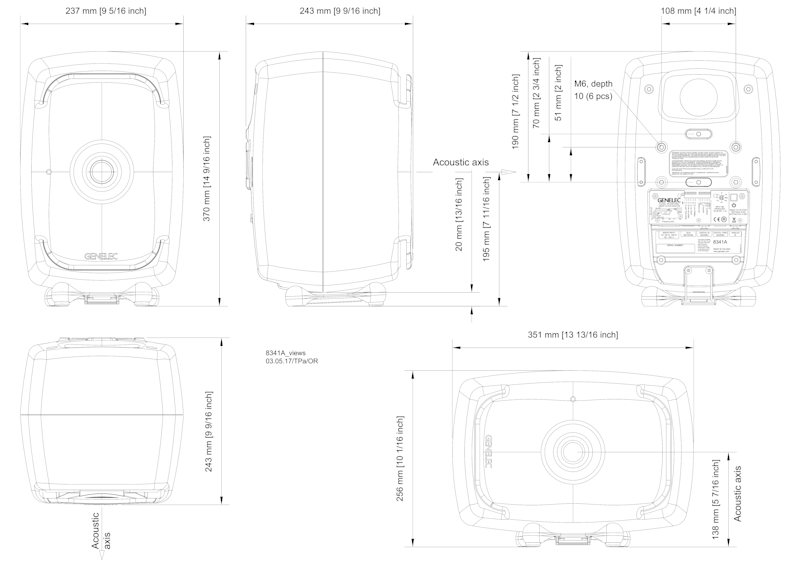
Kotelo
Kotelomateriaali
Die cast aluminium
Kotelotyyppi
Reflex port
Kaiutinelementit
Kaiutinelementtityyppi
Racetrack
8341A bass driver
Määrä
2
Leveys
170 mm
Korkeus
90 mm
Kaiutinelementtityyppi
Coaxial
8341A midrange driver cone (coaxial)
Halkaisija
90 mm
Kaiutinelementtityyppi
Coaxial
8341A treble driver metal dome (coaxial)
Halkaisija
19 mm
Suuntaavuus
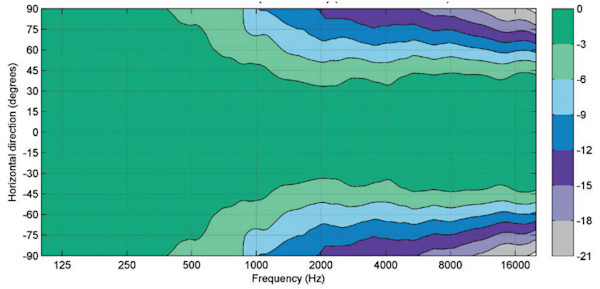
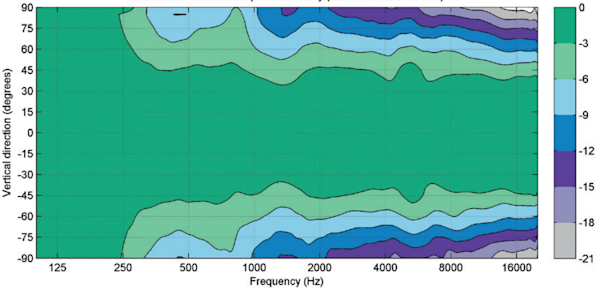
Harmoninen särö
> 100 Hz ≤0.5 %
Ryhmäviive
Viivästys äänen syntymiseen, mitattuna analogiasignaalitulosta korkeilla taajuuksilla.
GLM Extended Phase Linearity OFF-asennossa (ylempi käyrä)
3.3 ms (analogiatulo)
GLM Extended Phase Linearity ON-asennossa (alempi käyrä)
7.0 ms (analogiatulo)
Genelec ilmoittaa kaiuttimen suorituskykytiedoissa ajan, joka kuluu äänen muodostumiseen siitä, kun sähköinen signaali on saapunut kaiuttimen tuloliittimeen. Tämä aika ilmoitetaan latenssina ja ryhmäviivekäyrän antamana viiveenä ja kaiuttimen aiheuttama kokonaisviive on näiden kahden summa. Jotta saa käsityksen tämän kokonaisviiveen merkittävyydestä, on hyvä tietää, että kaiuttimen siirtäminen 1 m kauemman tuottaa noin 3 ms lisäviiveen.


Vahvistimet
Vahvistimet
250 W Class D
150 W Class D
150 W Class D
Käyttöjännite
100-240 VAC 50/60Hz
Tehonkulutus
ISS-valmiustilassa
≤0.5 W
Ilman kuormaa
≤16 W
Täysi kuormitus
250 W
Jakosuodin
Liitännät
Sisääntulo Analogisen signaalin sisäänmeno, XLR-naaras, balansoitu 10 kOhm
Sisääntulo Digitaalisen signaalin sisäänmeno, XLR-naaras 110 Ohm
Ulostulo Digitaalinen signaalin ulostulo / XLR-urosliitin 110 Ohm
2 x Ohjaus RJ45-liittimet
Jakotaajuus
Bass/Mid
500 Hz
Mid/Treble
3000 Hz
Tuotevaihtoehdot
Tuotekoodit
Lisävarusteet
Tuotekoodit
Tarkempia lisätietoja lisäksi tuoteoppaissa.
Avainteknologiat

Smart Active Monitor (SAM™)

Minimum Diffraction Coaxial (MDC™)

Acoustically Concealed Woofers (ACW™)

Active Crossovers

Directivity Control Waveguide (DCW™)

Intelligent Signal Sensing (ISS™)

Iso-Pod™ Stand

Minimum Diffraction Enclosure (MDE™)

Optimized Amplifiers

Protection Circuitry

Reflex Port Design

Versatile Mountings
Smart Active Monitor (SAM™) älykkäät kaiutinjärjestelmät sisältävät automaattisen kalibroinnin akustiseen ympäristöön.
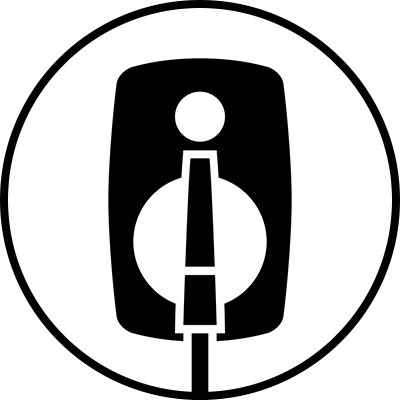
Kuluneen vuosikymmenen aikana sisällöntuotannon tarve on kasvanut ennätyslukemiin maailmanlaajuisesti. Tämä on aiheuttanut suuria muutoksia tuotantoyksiköiden toimintatapoihin kasvaneen työmäärän suorittamiseksi. Kasvava osa tuotannoista tehdään entistä pienemmissä työskentely-ympäristöissä. Tämä lisää merkittävästi huoneakustisia ongelmia jolloin äänentarkkailun luotettavuus heikkenee. Äänitarkkailijan tulisi pystyä luottamaan aukottomasti kaiutinjärjestelmään, jonka tulee tuottaa värittymätöntä ja särötöntä ääntä käytetystä äänenpaineesta riippumatta.
Huolellinen elektroakustinen suunnittelu toimii perustana kaikille 1200, 8200, 8300, 7200 ja 7300 –sarjojen älykkäille tarkkailukaiutintuotteille. SAM™ järjestelmän poikkeuksellisiin ominaisuuksiin kuuluu muun muassa kalibrointitoiminnallisuus Autocal™, joka mittaa ja sovittaa tarkkailukaiuttimet automaattisesti akustiseen ympäristöön kompensoiden tasoerot, viive-erot, taajuusvasteiden poikkeamat sekä subwoofereiden vaiheet.
SAM™ järjestelmiä ohjataan Genelecin Loudspeaker Manager (GLM™) ohjausverkkoa ja -sovellusta käyttäen, joka mahdollistaa äärimmäisen joustavan ja luotettavan monitorointijärjestelmän luomisen. GLM 3 on intuitiivinen tarkkailukaiuttimien hallintasovellus, joka mahdollistaa jopa 45 SAM™ -tuoteperheen tarkkailukaiuttimen ja subwooferin kytkemisen järjestelmään. Autocal™ automaattisen kalibrointitoiminnallisuuden lisäksi GLM 3 sovellus tarjoaa käyttäjälle mahdollisuuden säätää monipuolisesti tasoja, viiveitä sekä äänenvärisuodattimia. Parametrit ja asetukset voidaan tallentaa sekä tietokoneelle, että myös jokaiseen yksittäiseen GLM™ -ohjausverkkoon liitettyyn tarkkailukaiuttimeen ja subwooferiin. Tällöin ohjausverkkoa ja sovellusta ei välttämättä tarvita varsinaista tarkkailutyötä tehtäessä.
Kaikkia SAM™ järjestelmän tarjoamia toimintoja sekä äänen väriä voidaan säätää käyttäjän tarpeiden mukaisesti. Jopa työskentelytilan ja akustisen ympäristön vaihtuessa SAM™ teknologia auttaa sinua saavuttamaan parhaan mahdollisen ja johdonmukaisesti käyttäytyvän äänentarkkailujärjestelmän, joka tarjoaa neutraalin äänikuvan sekä todella alhaisen särötason.
Genelecin SAM™ -tuoteperhe tarjoaa kattavan, ratkaisukeskeisen ja älykkäästi verkottuvan järjestelmäkokonaisuuden, joka mahdollistaa sekä analogisen että digitaalisen signaalitien käyttämisen erilaisissa työskentely-ympäristöissä.
Minimum Diffraction Coaxial (MDC™) -koaksiaalielementti tuottaa ensiluokkaisen äänikuvan.
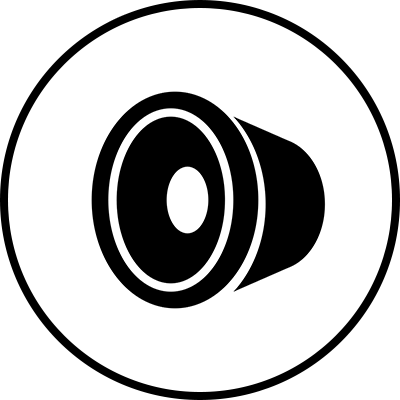
Aikaisempien koaksiaaliratkaisujen taajuusvaste on jokseekin rosoinen, mikä johtuu rakenteelle tyypillisistä diffraktio-ongelmista. Koaksiaalirakenne kuitenkin ratkaisee keskiääni- ja diskanttielementtien sijaintieroista aiheutuvat jakotaajuusalueen ongelmat. Näistä lähtökohdista on saanut alkunsa Genelecin Minimum Diffraction Coaxial (MDC™) -koaksiaaliteknologia: Se hyödyntää aikaisempien koaksiaaliratkaisujen edut mutta se myös korjaa niiden vakavia heikkouksia.
Ensimmäinen askel on minimoida keskiäänikartion liikepoikkeamaa, joka tehdään rajoittamalla elementin toistamaa matalien taajuuksien kaistaa. Toinen haaste on välttää diffraktiota aiheuttavat akustiset epäjatkuvuuslinjat. MDC™-koaksiaalielementin perusrakenne koostuu integroidusta keskiäänikalvo – ripustus – diskanttielementti -kokonaisuudesta. Koaksiaalielementin näkyvä osa koostuu keskiäänielementin ulkoripustuksena toimivasta joustavasta pinnasta ja sen keskellä sijaitsevasta kalottidiskanttielementistä. Sisäinen rakenne liittää keskiäänikartion diskanttielementtiin ilman akustista katkoa ja MDC™-elementti liittyy koteloon saumattomasti.

Koska havaittavia akustisia katkoja diskanttielementin ja keskiäänikartion välillä ei ole, myöskään diffraktiota ei synny. Keskiäänikartion profiili on tarkoin optimoitu ja se muodostaa integroidun suuntaimen diskanttielementin akustiselle säteilylle. Elementin ulkoreuna liittyy Directivity Control Waveguide (DCW™) -suuntaimeen, jolla hallitaan keskiäänisäteilijän dispersiota. Taajuusvaste kuunteluakselilla sekä sivukentässä on erittäin sulava, eikä siinä ole poikkeamia. Suuntaavuuskäyttäytyminen on erittäin hallittua.
Mullistava koaksiaalirakenne parantaa äänikuvaa sekä kokonaisäänenlaatua. Se mahdollistaa erinomaisen suoran taajuusvasteen, jonka ansiosta sisällön yksityiskohtien toisto on erittäin erottelevaa ja tarkkaa.

DCW™-koaksiaaliteknologian tärkeimmät ominaisuudet ovat:
- Diffraktiovapaa liitos diskanttielementin ja keskiäänikalvon välissä.
- Diffraktiovapaa liitos keskiäänikalvon ja DCW™-suuntaimen välissä.
- Genelecin kehittämä keskiäänikalvotekniikka – laminaattirakenne, jossa yhdistyvät jäykkä kartio ja elastiset, häviöttömät materiaalit esimerkiksi ulkoripustuksessa
- Keskiäänikalvo- ja ulkoripustusrakenne, joka vaimentaa mahdolliset epälineaarisuudet.
Näiden ominaisuuksien edut:
- Tasaisempi taajuusvaste.
- Elementit käyttäytyvät johdonmukaisesti koko toimintakaistallaan.
- Merkittävästi hallitumpi suuntaavuus kriittisellä taajuuskaistalla.
- Ripustuksen tasapainoinen dynamiikka minimoi akustista säröä.
- Rakenne mahdollistaa etulevyn optimoidun käytön säilyttäen 8000-sarjan muotoilun ja edut.
Acoustically Concealed Woofers (ACW™) -bassoelementit takaavat hallitun suuntaavuuden matalille taajuuksille saakka.

The Ones -kolmitiekaiuttimessa on uudenlaiset Acoustically Concealed Woofer (ACW™) -bassoelementit. Kotelon etulevyn taakse piilotetut elementit säteilevät kotelon päissä olevien aukkojen kautta.
Kahden bassoelementin sijoitus laajentaa akustisesti koaksiaalisen säteilykäyttäytymisen matalille taajuuksille. Kahden toisistaan tietyllä etäisyydellä sijaitsevan bassoelementin järjestelmä käyttäytyy akustisesti matalien taajuuksien suuntaavuuden osalta yhden suuren elementin tavoin. Kahden bassoelementin järjestelmä laajentaa hallitun suuntaavuuden matalammille taajuuksille kotelon etulevyn pituuden sallimissa rajoissa.
ACW™-teknologian ansiosta bassoelementit ja kotelon aukot ovat akustisesti läpinäkymättömiä keskiääni- ja diskanttitaajuuksia toistavalle Minimum Diffraction Coaxial (MDC™) -koaksiaalielementille. Säteilyaukkojen koko on optimoitu suunnitteluvaiheessa ja niiden kaarevuus minimoi säröä.
ACW™-rakennetta hyödynnettäessä koko etulevyn pinta-alaa voidaan käyttää yhtenä jättimäisenä Maximized Directivity Control Waveguide (MaxDCW™) -suuntaimena, joka on integroitu Minimum Diffraction Enclosure (MDE™) -koteloon.
ACW™-teknologia tarjoaa huomattavasti suuremman kaiuttimen matalien taajuuksien suuntaavuuskäyttäytymisen kompaktissa kotelossa. Hallittu matalien taajuuksien suuntaavuus vähentää huoneen aiheuttamia haittavaikutuksia merkittävästi.
Aktiivisessa jakosuotimessa käsitellään linjatasoista signaalia.
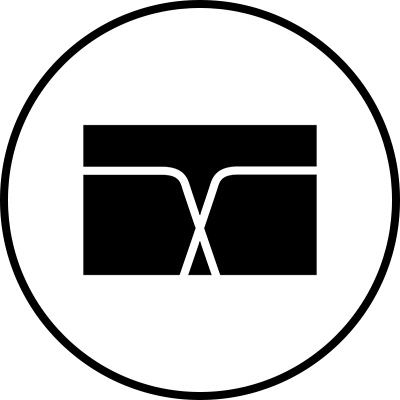
Aktiiviset jakosuotimet jakavat audiosignaalin taajuuskaistoihin, jotka ohjataan erillisiin tehovahvistimiin. Vahvistimet on kytketty kyseiselle taajuuskaistalle optimoituihin kaiutinelementteihin.
Aktiivikaiuttimissa käytetään sekä digitaalisia että analogisia jakosuotimia. Genelecin digitaalisissa aktiivijakosuotimissa on myös muita signaalinkäsittelytoiminnallisuuksia, kuten elementtien suojaus, lentoaikakompensointi ja taajuuskorjaus.
Genelecin analogisissa aktiivijakosuotimissa perustuu elektronisiin komponentteihin, jotka käsittelevät matalatasoista signaalia ennen tehovahvistusta. Aktiiviset jakosuotimet eroavat toimintaperiaatteeltaan passiivisista jakosuotimista, joissa käsitellään voimakkaita signaaleja, suurta virtaa ja toisinaan myös suurta jännitettä.
Tyypillisessä kaksitiekaiuttimessa tulosignaali jakosuodatetaan kahdelle erilliselle tehovahvistimelle, joista toinen ohjaa bassoelementtiä ja toinen diskanttielementtiä.
Aktiivisella jakosuodinteknologialla on useita etuja:
- Elementin sähködynaamiset muutokset eivät vaikuta taajuusvasteeseen.
- Signaalia voidaan säätää joustavasti käytettävän elementin ominaisuuksien mukaisesti.
- Jokaisen elementin tulosignaali prosessoidaan ja vahvistetaan yksilöllisesti. Yksittäisten elementtien signaalit eivät häiritse toisiaan, mikä vähentää keskeismodulaatiosäröä ja yliohjausongelmia.
- Elementtien välisiä herkkyyseroja voidaan kompensoida.
- Elementin ominaisuuksiin liittyviä taajuus- ja vaihevasteen poikkeamia voidaan kompensoida halutulla päästökaistalla.
- Aktiivinen jakosuodin mahdollistaa lisäksi taajuusvasteen säätämisen sekä kaiuttimen optimoinnin kaiutinjärjestelmään ja erilaisiin kuunteluympäristöihin ilman ulkoisia taajuuskorjaimia. Tuloksena on yksinkertainen, luotettava, tehokas, tarkka ja johdonmukaisesti käyttäytyvä aktiivikaiutinjärjestelmä.
Directivity Control Waveguide (DCW™) -suuntain tuottaa tasaisen taajuusvasteen laajalle kuuntelualueelle.

Vallankumouksellinen Directivity Control Waveguide™ (DCW™) -teknologia parantaa huomattavasti suoraan säteilevän monitiekaiuttimen suorituskykyä.
Tavoite on sovittaa taajuusvaste ja elementtien suuntaavuus kaiuttimessa. Lopputuloksena saavutetaan erinomainen taajuusvaste sekä kaiuttimen akustisella akselilla että sivusta mitattuna.
Parantunut kontrolloitu suuntaavuus vähentää huoneheijastumia kuuntelupaikalle. Tämä parantaa stereokuvaa ja asettaa vähemmän vaatimuksia huoneakustiikalle.
DCW-teknologia parantaa elementin herkkyyttä jopa +6 dB:ä, mikä mahdollistaa suuremman kokonaisäänenpaineen vähentäen samalla säröä ja parantaen luotettavuutta.
###DCW™-suuntaimen tärkeimmät edut:
- Tasainen taajuusvaste laajemmalle kuuntelualueelle
- Parantunut suoran äänen suhde heijastuneeseen ääneen vähentää tilan vaikutusta lopputulokseen
- Tarkempi stereokuva
- Parantunut elementtien hyötysuhde
- Järjestelmän suurempi maksimiäänenpaine
- Pienentynyt elementtien särö
- Vähemmän kaiutinkotelon reunan aiheuttamaa äänen heijastumista
- Parantunut elementtien luotettavuus, koska saman äänenpaineen tuottamiseen tarvitaan vähemmän tehoa ja pienempi kalvon liikepoikkeama
Intelligent Signal Sensing (ISS™) -valmiustilatoiminto vähentää virrankulutusta.

Genelec kehitti vuonna 2013 Intelligent Signal-Sensing -piirin, joka täyttää sekä ErP-direktiivin vaatimukset että Genelecin omat direktiiviä tiukemmat vastuullisuusvaatimukset.
ISS™-piiri seuraa kaiuttimien signaalinsyöttöä ja havaitsee, milloin signaali on käytössä. Jos ISS-piiri ei havaitse audiosignaalia hetkeen, se asettaa kaiuttimen valmiustilaan, jossa kaiuttimen virrankulutus on alle 0,5 wattia. Kun syöttösignaali havaitaan, kaiutin kytkeytyy päälle itsestään. Kaiutinjärjestelmä alkaa siis säästää sähköä heti, kun työskentely katkeaa.
Jokaisen kaiuttimen taustalevyssä on huonevasteen säätimien vieressä ISS Disable -kytkin. Kun päävirtakytkin on asennossa ON, ISS™-toiminto on oletusarvoisesti päällä.
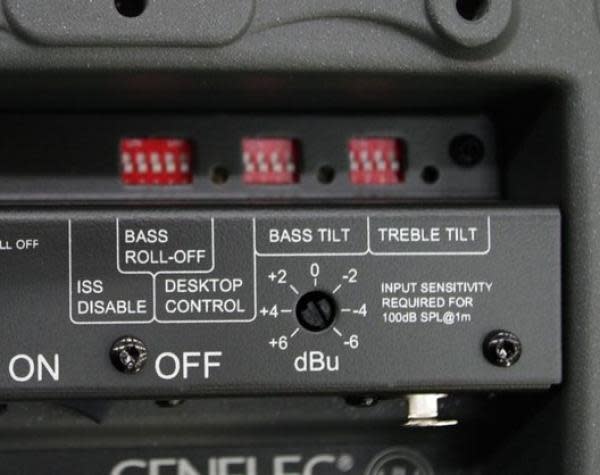
Jos ISS-toimintoa ei haluta käyttää, se voidaan poistaa käytöstä kääntämällä ISS Disable -kytkin asentoon ON. Tällöin kaiuttimen virransyöttöä ohjataan päävirtakytkimestä.
Päävirtakytkin katkaisee kaiuttimen virransyötön kokonaan.
Mekaanisia värinöitä vaimentava Iso-Pod™ -alusta parantaa äänikuvan tarkkuutta.

Vaikka vapaasti seisovien kaiuttimien alle suositellaan yleisesti tukevia jalustoja, on varsin yleistä että kaiuttimet sijoitetaan suoraan pöydälle tai äänipöydän mittarisillalle. Tällaisesta sijoituksesta aiheutuu kuitenkin haitallisia lieveilmiöitä: Kaiuttimen suuntaus kohti kuulijaa on vaikeaa ja kaiuttimen sekä alustan välille syntyy haitallisia mekaanisia värinöitä. Kaiuttimen ollessa pöydällä työtasosta aiheutuu heijastumia, jotka aiheuttavat kampasuodinilmiöstä johtuvaa taajuusvasteen vääristymistä.
Genelec on kehittänyt näiden ongelmien ratkaisemiseksi tehokkaan ja käytännöllisen Isolation Positioner/Decoupler (Iso-Pod™) -alustan, joka kiinnitetään jousella kaiuttimen alumiinikoteloon. Alusta on valmistettu joustavasta kumimaisesta materiaalista. Tukevasti sekä pysty- että vaaka-asentoon Iso-Pod-alustan päälle asettuvaa kaiutinta voidaan kallistaa ±15 asteen kulmaan. Kaiuttimen akustinen akseli voidaan kohdistaa tarkasti kohti kuuntelijaa säätämällä kaiuttimen kulmaa Iso-Pod-alustan päällä.
Mekaaniset eristys- ja vaimennusominaisuudet vähentävät tukipinnoista syntyvän haitallisen värähtelyn aiheuttamaa keskiäänen värittymistä.
Innovatiivinen Iso-Pod™-alusta on oleellinen osa Genelecin kaiutinmuotoilua ja se tarjoaa huomattavia käytettävyyteen sekä äänenlaatuun vaikuttavia etuja.
Minimum Diffraction Enclosure (MDE™) -kotelo tuottaa värittymättömän äänen.
Etulevyn akustisista epäjatkuvuuskohdista syntyvä diffraktio on tyypillinen vapaasti sijoiteltavan kaiuttimen ongelma. Kotelon terävät kulmat aiheuttavat heijastuksista johtuvia toisioäänilähteitä, jotka värittävät ääntä ja heikentävät äänikuvan tarkkuutta.
Parantaakseen vapaasti sijoiteltavan kaiuttimen taajuusvasteen sekä tehovasteen tasaisuutta, Genelec on kehittänyt innovatiivisen Minimum Diffraction Enclosure (MDE™) -kaiutinkotelon, jossa on kaarevat sivut sekä pyöristetyt kulmat. Poikkeuksellisen tasaisen taajuusvasteen lisäksi kotelorakenteella saavutetaan erinomaiset äänikuvaominaisuudet.
Kompaktin ja tyylikkään ulkoasun saavuttamiseksi kotelon materiaaliksi on valittu painevalettu alumiini, joka mahdollistaa kotelon kokoon suhteutettuna suuren sisätilavuuden bassoelementin herkkyyden maksimoimiseksi. Alumiini on kevyttä, jäykkää ja hyvin vaimentavaa, joten se on erinomainen materiaali ohutseinäisen ja akustisesti "kuolleen" kotelon valmistamiseen. Alumiinikotelo suojaa tehokkaasti elektromagneettiselta säteilyltä ja se toimii myös vahvistimien jäähdytyselementtinä. Kotelo valetaan kahtena kappaleena, jolloin se pystytään avaamaan helposti esimerkiksi huoltoa varten.
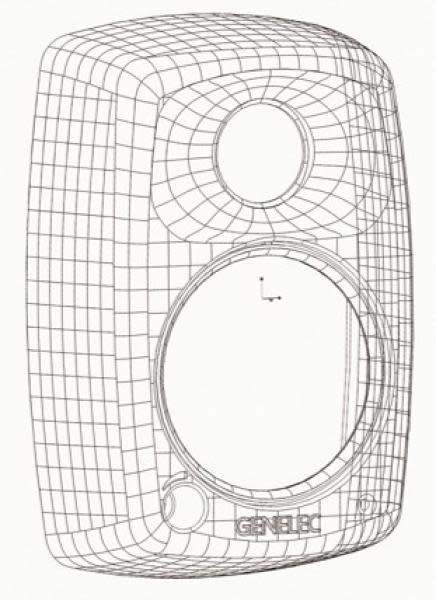
Directivity Control Waveguide (DCW™) -suuntain integroidaan MDE™-koteloon hallitun suuntaavuuden saavuttamiseksi. Vakiosuuntaavuuden alarajataajuus määräytyy suuntaimen koon perusteella, jolloin suuremmalla suuntainpinta-alalla saavutetaan hallitumpi suuntaavuuskäyttäytyminen. Hallittu sivukenttäsäteily mahdollistaa suuren käyttökelpoisen kuuntelualueen, mikä on erittäin tärkeää monikanavaisessa äänentarkkailussa. Hallittu suuntaavuus vähentää myös rajapintaheijasteiden merkitystä, jolloin monitorointijärjestelmä toimii johdonmukaisesti erilaisissa akustisissa ympäristöissä.

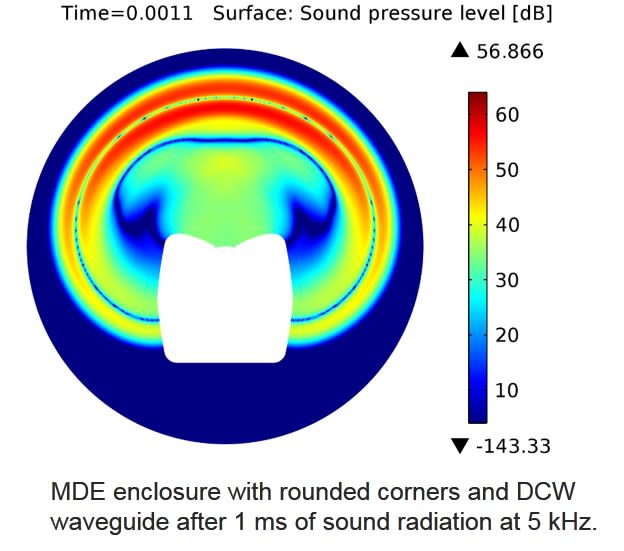
Elementtikohtaisesti optimoidut tehovahvistimet.
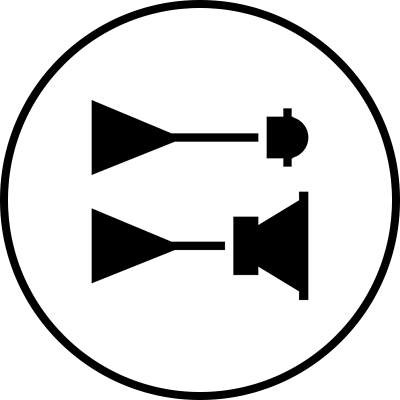
Elektroniset jakosuotimet jakavat audiosignaalin taajuuskaistan osiin, jotka voidaan ohjata erillisiin vahvistimiin. Vahvistimet on liitetty kyseiselle taajuuskaistalle optimoituihin muuntimiin.
Tyypillisessä kaksitiekaiuttimessa aktiivinen jakosuodin tarvitsee kaksi vahvistinta: yhden bassoelementille ja toisen diskanttielementille. Vahvistimet liitetään suoraan aktiivikaiuttimien elementteihin, jolloin vahvistimien kuormitus on tunnettu ja yksinkertaisempi. Jokaisella elementtikohtaisella vahvistimella on vain rajallinen taajuusalue, jota se vahvistaa (vahvistin sijoitetaan aktiivisen jakosuotimen taakse), mikä yksinkertaistaa rakennetta.
Aktiivisella rakenteella on useita etuja:
- Vahvistimet liitetään suoraan kaiutinelementteihin, mikä tehostaa vahvistimien elementin äänikäämin vaimennuksen hallintaa ja vähentää dynaamisten muutosten esiintymistä elementin sähköominaisuuksissa. Se saattaa parantaa järjestelmän siirtymävastetta.
- Vahvistimen lähtövaatimukset ovat pienemmät. Kun energiaa ei mene hukkaan passiivisen jakosuotimen komponenteissa, vahvistimen tehovaatimukset ovat huomattavasti pienemmät (jopa puolta pienemmät joissakin tapauksissa) ilman, että kaiuttimen akustinen teho heikkenee. Tämä saattaa pienentää kustannuksia ja parantaa äänenlaatua ja järjestelmän luotettavuutta.
- Kun vahvistimen ja elementin välissä ei tapahdu hävikkiä, saavutetaan äärimmäinen akustinen tehokkuus.
- Aktiivinen teknologia pystyy tuottamaan ylivoimaisen äänentoiston suhteessa kokoon ja matalaan alarajataajuuteen.
- Kaikki kaiuttimet toimitetaan tehtaalla sovitettuina järjestelminä (vahvistimet, jakosuotimet ja kotelo-elementtijärjestelmät).
Yliohjauksen suojapiiri takaa turvallisen käytön ja elementtien pitkäikäisyyden.
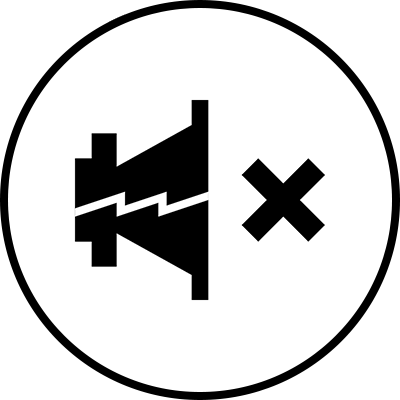
Kriittisissä audiotuotantoympäristöissä on ratkaisevaa, että monitorointijärjestelmä on luotettava ja aina käytettävissä. Yksi tärkeimmistä syistä Genelecin menestykseen lähetystarkkaamokäytössä on tuotteidemme luotettavuus. Luotettavuuden takeena on sisäinen suojapiiri, joka on ollut kaikissa tuotteissa vuodesta 1978 lähtien.
Suojapiiri ehkäisee elementtien vikatiloja havaitsemalla signaalitasoja. Mikäli signaalissa esiintyy yhtäkkisiä piikkejä tai jatkuvia liian korkeita tasoja, suojapiiri laskee signaalin tasoa automaattisesti. Suojapiirin toiminta ei luonnollisestikaan vaikuta äänenlaatuun millään tavalla työskenneltäessä kaiuttimen määritellyissä käyttöolosuhteissa. Se vain ehkäisee signaaleja rikkomasta kaiutinta.
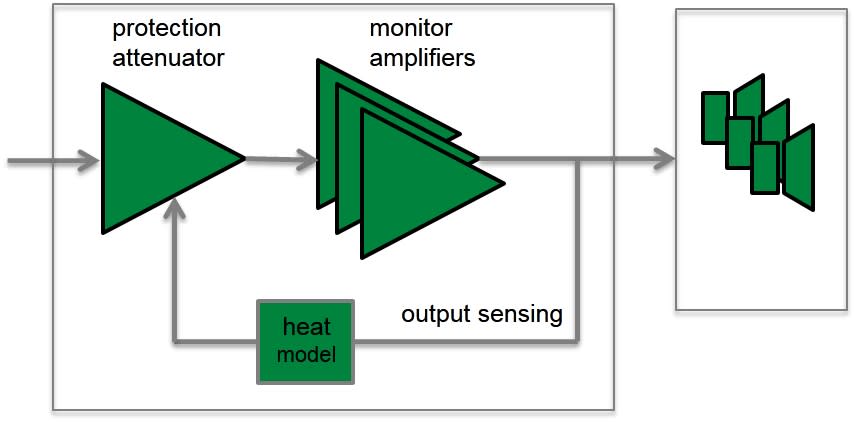
Suojapiirin ominaisuudet ja edut:
- Laskee signaalin tasoa tarvittaessa (esimerkiksi kun elementin äänikäämin lämpötila saavuttaa turvarajan), mikä parantaa kaiuttimen luotettavuutta merkittävästi.
- Jokaisen kaiuttimen ja alabassokaiuttimen sopiva suojapiirirakenne sallii järjestelmän äänitason maksimoimisen.
Edistynyt refleksiputken muotoilu parantaa bassotoiston ulottuvuutta.

Genelec käytti bassorefleksirakennetta jo ensimmäisessä tarkkailukaiuttimessaan S30:ssa vuonna 1978. Genelec on siitä lähtien tutkinut ja kehittänyt refleksiputken suorituskykyä sekä tehokkuutta. Kehitystyön tavoite on ollut parantaa bassotoiston ulottuvuutta ja äänenpainekapasiteettia erinomaisen matalien taajuuksien artikulaation ja tarkkuuden tuottamiseksi.
Sekä bassoelementti että refleksiaukko vaikuttavat refleksikotelon kokonaissäteilyyn. Suurin osa säteilystä on lähtöisin elementistä, mutta refleksikotelon resonanssitaajuudella elementin liikepoikkeaman amplitudi on pieni, jolloin suurin osa säteilystä tulee aukosta.
Virtausnopeuden minimoimiseksi putken poikkipinta-alan täytyy olla suuri. Kaiutinkotelon koko rajoittaa usein refleksiputken pituutta.
Pitkä kaareva refleksiputki maksimoi ilmavirtauksen, jotta kaiutin pystyy tuottamaan syvän bassotoiston ilman kompressiota. Putki päättyy leveään pyöreäreunaiseen aukkoon, joka sijaitsee kotelon takana minimoiden putken virtausääniä ja tuottaen erinomaisen bassoartikulaation.
Putken kaareva muoto on tarkoin suunniteltu ja se vähentää virtausääniä, kompressiota ja säröä. Putken sisäpään muotoilu minimoi suorille refleksiputkille tyypillisiä yskähdysääniä ja turbulenssia.
Huolellisesti suunniteltu refleksiputken rakenne vähentää bassoelementin liikepoikkeamaa ja parantaa matalien taajuuksien toiston lineaarisuutta sekä äänenpainekapasiteettia.
Monipuoliset kiinnitysvaihtoehdot soveltuvat useimpiin asennusratkaisuihin.

Genelecin kaiuttimissa on monipuoliset ripustusmahdollisuudet, jotka tekevät asennuksesta helppoa kaikissa kohteissa. Oikein sijoitetut kaiuttimet käyttäytyvät ihanteellisesti erilaisissa käyttöympäristöissä.
Laaja lisävarustevalikoimamme ja painevalettujen alumiinikoteloiden takalevyihin integroidut kiinteät M6-kiinnityspisteet tarjoavat ratkaisun useimpiin asennustilanteisiin. Pienissä kaiutinmalleissa kotelon pohjassa on 3/8-tuuman kierreinsertti, jota käyttäen kaiutin voidaan asentaa tukevaan mikrofonitelineeseen tai jalustaan. Suuremmissa ja painavammissa malleissa on M10-kiinnityspisteet. Lattiatelineisiin on saatavilla myös mallikohtaiset Iso-Pod jalusta-adapterit, joiden avulla saavutetaan kattavat säätömahdollisuudet sekä hyvä mekaaninen eristys kaiuttimen ja jalustan välille.
Näiden ominaisuuksien ansiosta tuotteitamme käytetään nykypäivänä ammattikäyttökohteiden lisäksi sekä julkistiloissa että kotikohteissa kaikkialla maailmassa.
Referenssit
Toni Wirtanen luottaa Genelecin The Ones -sarjan 8341-monitoreihin
One on One with Eicca Toppinen, Apocalyptica | Genelec 8341 | Interview
Genelec Visits Morten Lindberg’s Stunning Immersive Audio Studio
We are The Ones
Toni Wirtanen luottaa Genelecin The Ones -sarjan 8341-monitoreihin
Apulannan keulahahmo, ja The Voice of Finlandista ja Vain elämää -formaateista tuttu Toni Wirtanen on käyttänyt Genelecin kaiuttimia jo 1990-luvulta lähtien, ja tuolloin hankitut kaiuttimet ovat edelleen lähes päivittäisessä käytössä Apulandiassa. Vierailimme hänen uudessa kotistudiossaan, joka on varustettu Genelecin The Ones -sarjan 8341 malleilla.
One on One with Eicca Toppinen, Apocalyptica | Genelec 8341 | Interview
Eicca Toppinen, multi-instrumentalist, and co-founder of cello metal band Apocalyptica, says he doesn’t have a formula for writing music but is inspired by the sound of different instruments.
Genelec Visits Morten Lindberg’s Stunning Immersive Audio Studio
In the world of immersive music recording, no-one has done more than Grammy-winning sound engineer and music producer Morten Lindberg to set the gold standard for what can be achieved in this field.
We visited Morten at his incredible studio in Oslo, Norway to talk about his approach to immersive recording, and how his new 7.1.4 Genelec monitoring system has become an essential part of his workflow.
Welcome to a fascinating insight into the world of a true immersive audio pioneer.
Etsi jälleenmyyjäsi

Dokumentit
Dokumentit
Operating Manual 8341A Brochure The Ones The Ones 产品手册 Immersive Solutions Brochure GENELEC真力-8341a-用户操作手册Tiedostot
8341A - Simulation File (CLF) Line Drawings (PDF) 8341A Line Drawings (DWG) 8341A The Acoustic Design of Minimum Diffraction Coaxial Loudspeakers with Integrated Waveguides 8341A - Simulation File (GLL)Arviot
Audio Media International: Genelec The Ones 8341A Headliner Magazine: Genelec 8341A Studio Monitor review Tape Op Review: 8341A SAM Monitors & GLM User Kit Production Expert: Genelec 8331 SAM & 8341 SAM "The Ones" Studio Monitors & GLM™ 3 - Do They Re-Write The Rule Book?, August 2018 (UK) Sound on Sound Magazine: Genelec The Ones by Hugh Robjohns, July 2017 (UK) MusicTech Magazine: Genelec The Ones SAM 8331 & 8341 Review – Raising The Bar, November 2017 (GB) Recording Magazine (PDF): Genelec 8341 and 8331 Studio Monitors and GLM 3 Software, March 2018 (US) Stereo Sound: 8331 & 8341 Review, November 2017 (Japan) Resolution Magazine/Monitoring Supplement: “Creating Ultimate Point Source”, May 2017 (GB)"These studio monitors pack a serious amount of technology into a very compact package. Can all this tech combat the issues associated with powerful rear ported designs and can the GLM™ 3 system cope with a truly dreadful set of listening circumstances?"
The Production Expert's comprehensive review "Genelec 8331 SAM & 8341 SAM "The Ones" Studio Monitors & GLM™ 3 - Do They Re-Write The Rule Book?" does not only list the pros and cons, but also describes the user experience of the products.
The review was published in August 2018.
"The culmination of years of R&D, these revolutionary new speakers offer performance way beyond what you’d expect from their size."
-Hugh Robjohns, the author of the review article
Sound on Sound Magazine's (UK) review of 8331, 8341 and 8351 SAM™ Studio Monitor. Written by Hugh Robjohns. Published July 2017.
Read the full review: Sound on Sound 8331, 8341 and 8351 Review
MusicTech Magazine's (GB) review of 8331 and 8341 SAM™ Studio Monitor. Published in November 2017.
MusicTech magazine's review of Genelec 8331 and 8341 studio monitors. The review is written by Andy Jones and it was published on MusicTech's website in November 2017.
"Two new 3-way coaxial monitors to fit any room—and software to ease the process."
Recording Magazine's (US) review of Genelec 8341 and 8331 studio monitors and GLM 3 software written by Paul Vnuk Jr. and Mike Metlay. The review was published in March 2018.
Read the full review: Recording Magazine 8331, 8341, and GLM 3™ Review
Stereo Sound Online Magazine's (JP) review of 8331 and 8341 SAM™ Studio Monitor. The review is written in Japanese and it was published in November 2017.
Stereo Sound Online Magazine's (JP) review of 8331 and 8341 SAM™ Studio Monitor. The review is written in Japanese and it was published in November 2017.
Read the full review: Stereo Sound 8331 & 8341 Review
"Collectively, the three monitors make up The Ones, a range combining the best of coaxial and point source to create what Genelec is calling Ultimate Point Source. Resolution speaks to Aki Mäkivirta to find out more."
Resolution Magazine Monitoring Supplement's (GB) review of The Ones. Published May 2017.
Read the full review: Resolution Magazine/Monitoring Supplement The Ones Review
hello











